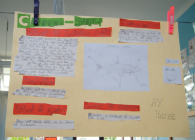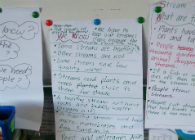Session 5
Learning Outcomes
At the end of the session students will be able to …
1. understand why streams are significant places, what their value is and whether they should be protected places
Resources
Scenario cards (included below)
Conversations (included below)
Curriculum links
Key competencies
• Thinking
• Participating and contributing
• Relating to others
Social Studies, Science, Health, Science, Drama, Visual Arts
Activities
1. What’s Up with our stream?
• Have students imagine they are aquatic animals living in their stream. Give out the following scenario cards, one to each group . They could …
Act out the scenario with some students taking the role of the protagonists
Write a letter to the protagonist/s
Draw a cartoon of the scenario
They could make suggestions as to what the protagonists should do instead.
What do you do when …
A school empties their swimming pool down the stormwater drain. The stormwater drain empties into the stream. The water has a lot of chlorine in it. You and your friends get sick.
What do you do when …
A person washes their car on the road outside their house. The water goes down the stormwater drain and into the stream. The detergent in the water makes you and your friends sick.
What do you do when …
A property developer cuts down the trees beside your stream to show off the view for the new houses he wants to build. Now you don’t have any food and it gets really hot during the day with the sun beating down.
What do you do when …
A property developer wants to build new houses but first he has to flatten the land. He bulldozes the soil and removes it but some ends up in the stream. The stream becomes muddy and the banks start to erode (the sides fall in).
What do you do when …
There are many beautiful gardens in your community. However some people throw their weeds and other garden waste beside the stream because they don’t want to pay to take their waste to the landfill. Weeds start to grow beside the stream and stop native plants from growing.
What do you do when …
The local shopping centre needs more space for a carpark. The big new carpark will be a hard surface which means rain water can’t soak into the ground. This water will go into a stormwater drain and into the stream. Part of the stream will be piped under the carpark.
2. What is our school doing for our stream now?
• Find out what activities your school has been involved with to help protect your local stream (eg clean ups, weeding, planting, painting stormwater drains, cutting down on travel by car and reducing polluted water in drains, growing native trees in our grounds to food sources for birds and insects in our area).
Record these under the heading POSITIVE.
• What are some of the things we are doing which may not be so good for our streams (eg over-full rubbish bins blowing on to stream area, not many natives, not taking care with drains).
Record these under the heading NEGATIVE.
3. What are others doing for our stream?
• Find out if any other groups are involved in restoring your local stream. Who are they? What are they doing?
Invite someone from this group to come and talk to the class.
• Who else could be involved in the restoration of your stream?
Extension
• Donut
Form a donut – that is an inner and outer circle, with the same number of students in each circle, facing each other. Give students one of the conversations below. They carry out this conversation in pairs. Stop them after about 30 seconds. Ask the outer circle to move one place to the left. They then have the conversation with their new partner. Repeat once more, and then give the students a new conversation. Choose from the following and add more of your own.
Conversations
A teenager (inner circle) is telling his friend (outer circle) why he should bike to school instead of driving his car.
A student from your school (outer circle) is telling her neighbour (inner circle) why she shouldn’t be spraying pesticides on her fruit trees next to the stream.
A local shop keeper (inner circle) is telling a truck driver (outer circle) why he shouldn’t empty his waste onto the carpark.
A Council person (outer circle) is explaining to a resident who lives by a stream (inner circle) why they shouldn’t throw their weeds over their fence into the stream.
Your teacher (inner circle) is telling a student (outer circle) why she shouldn’t pour paint down the stormwater drain.
The Mayor (inner circle) is telling a TV reporter (outer circle) why it is important to look after our streams.
A bush walker (outer circle) is telling a possum hunter (inner circle) why he shouldn’t lay poisonous bait next to the stream.
A local kaumatua (inner circle) is telling your local Councillor (outer circle) why it is important for Maori to be involved in environmental projects.
A grandmother (inner circle) is telling you (outer circle) what it’s like living next to a healthy stream.
A student (outer circle) is telling a local garage owner (inner circle) why he shouldn’t throw his used oil containers into the bushes by the stream.
A local elder (inner circle) is explaining to a young father (outer circle) how their swimming hole and dam is damaging their backyard stream.
A child (outer circle) is explaining to a parent helper (inner circle) how the trees they are planting are important to the mauri of the stream.
Assessment
• An ideal future for our stream
Ask students to show (photo collage, diagrams, writing, drawings, painting) how they would like to see their stream in future.
UNLESS someone like you cares a whole awful lot,
Nothing is going to get better.
It’s not
Ideas could be put together to create a class mural of the stream
 |
 |
 |
| Session 1 Up the Creek |
Session 2 Wai … it goes round and round |
Session 3 Oh for a cool stream! |
 |
 |
 |
| Session 4 Hey! Watch where you chuck your muck! |
Session 5 Time to Come Clean |
Session 6 We’re Scheming for a Clean Stream |

